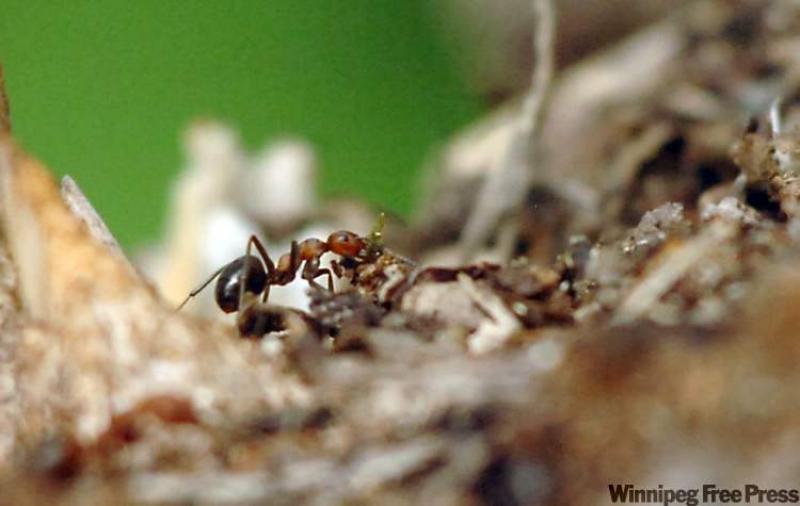QUESTION: We have a mountainous anthill which is rapidly destroying our perennial garden. HELP! Thanks, Ditte, Winnipeg, Man.
ANSWER: There are a number of solutions for tackling ants, because what works for one will not necessarily work for another since there is such a large variety of ant species. To begin with, many ants will stay away if they smell an odour unpleasant to them such as cinnamon, garlic, tea leaves or coffee grounds. You can also sprinkle anthills with dry oatmeal, cornmeal or Cornflakes cereal. Another option is to make what I like to call rhubarb tea. In a stainless-steel pot, boil rhubarb leaves with water. Pour the cooled liquid onto anthills. This helps get rid of ants and because of the oxalic acid in rhubarb, your pots will come out sparkly clean! You can make your own ant-ridder by combining 1 cup borax with 2 tbsp. icing sugar; add a few drops of honey. Trickle near ants or leave this solution in a bowl and place it outside where ants are a problem. Keep this combination away from grass, pets and children. Lastly, push a metal pipe into the ant hill and pour hot water into the pipe.
QUESTION: I have stainless-steel cutlery that has turned black. I have tried cleaner, the foil method, and have not had much luck. I did try bleach with dish soap and that did clean them a bit, but there must be something better. Thank you, Judy, Winnipeg
ANSWER: Well, I'm not sure what you used for the "foil method," but let me give you my favourite foil trick -- I love it! Get a baking pan and loosely lay crumpled aluminum foil on the bottom. Into the pan drop one-quarter cup Arm and Hammer So Clean washing soda (find it in the laundry department of grocery stores) and enough hot water to cover the bottom of the pan. Put the stainless steel into the water and washing soda for about 5 mins. If anything is going to get rid of the black, this is it!
QUESTION: I have your books, but was unable to find a "cure" for ink stains on a suede leather jacket. I haven't had it for very long, so I don't want to give it up just yet. Thanks so much! Sandra, Winnipeg
ANSWER: The problem with ink stains on leather and suede is that as ink seeps into the textile it actually dyes it, which makes it very difficult to remove. Begin with this easy solution: Sprinkle the area with baking soda and then using a stiff dampened brush, move the brush back and forth until the stain is gone. If the stain remains, dab the area with rubbing alcohol and a white cloth. If you see ink appearing on your cloth, continue until the stain is gone. If dye from the jacket lifts, stop cleaning. In this case, your best bet is to take the jacket to professional leather cleaners or leave the jacket as is. As you wear it, the ink will likely fade over time.
QUESTION: I have a tablecloth that my aunt's mother crocheted and it's about 40 years old. It appears to have either tea, coffee or maybe rust stains on it. I would like to try and remove the stains. Have you any suggestions? The dry cleaners don't want to take a chance on it because of its age. Thanks, Cathy, Brandon, Man.
ANSWER: If I were in your situation, I would put the tablecloth in 12 cups of hot water and 1 cup of borax or washing soda. Let soak for an hour. While wearing rubber gloves, remove the tablecloth, rinse with water and lay flat to dry. Another option is to soak the tablecloth in 1 cup of 3 per cent hydrogen peroxide and 8 cups water. Leave for an hour and lay outside to dry. Worst-case scenario, soak the tablecloth in a commercial product called Iron Out and hot water, rinse in cold water and lay flat to dry. Note: Iron Out is risky because it is a strong toxic product.
Feedback from reader:
Hi, Reena,
I read your reply regarding smelly towels as a result of front-end-loading washing machines. I feel I have to respond because this is a much bigger issue than it might seem at first.
The odour is not caused by dyes but by bacteria growing in the fabric of the face cloths and towels, particularly when moistened by a couple of uses. It can be transferred to clothes in the wash and produce rashes. Some new clothes, towels or other cloth products have this smell even when new because they have already been contaminated with bacteria.
We have a front-loader that has had this issue since almost new. Virtually all low-water-consumption washing machines have this problem, which is why you are seeing machines on the market with sanitizing cycles, silver interiors and steam cycles in part. The manufacturers recommend the doors be left open to help dry the interiors and door seals to reduce bacterial growth. They also recommend an occasional wash cycle with chlorine bleach with the washer empty to kill any growth. I do not know if they acknowledge that it is mostly a bacterial problem, but speak around it with terms like "musty odours" and "mouldy smells." It is not mould or algae.
The smell is quite particular to these bacteria and readily identified and is often termed a "musty" odour. It can withstand temperatures as high as 42 degrees Celsius, so a normal wash cycle will not usually touch it. Chlorine bleach is an effective remedy. However, do not use chlorine bleach with any other product, as chlorine gas will result.
Often, large-volume washers lend themselves to overloading, and combined with the small amount of water used, simply do not get clothes as clean as the old agitator-style washers.
The clothes must tumble to get clean and can't if the machine is too full. We have a recurring brown film on the door seal of our machine that is likely bacterial. Soap residue is food for these bacteria, as are skin particles and, it seems, just about anything. Liquid fabric-softener residue may also provide a medium for these bacteria. I work in the chemical business and deal with water treatment in particular. Yours truly, Neil, Winnipeg
Fabulous tips of the week:
-- To bring down a fever, soak a cloth with vinegar and wrap the cloth around the patient's feet.
-- Gently bleach towels and sheets by soaking them in either lemon juice or 3 per cent hydrogen peroxide and water. Lay them outside on the grass or hang to dry.
-- To get rid of rust stains in the tub, mix one-half cup 3 percent hydrogen peroxide with 1 tsp. cream of tartar. Apply to stains. Wait 10 mins. and scrub. Citric acid is also very effective in removing rust stains. Sprinkle onto dampened area. Wait 10 mins. and scrub.
I enjoy your questions and tips. Keep them coming.
Reena Nerbas is the author of the national bestselling Household Solutions series. Her website is www.householdsolutions.org. You can contact her at Box 429, Blumenort, Man., ROA 0C0.




